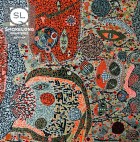The ending of “Librarian” is powerful, and I enjoy that it concludes where, in a sense, things are still unfolding, with the narrator “at the ready.” When you craft story endings, do you hope to provide answers, spark questions, or do something else entirely?
I often don’t know where I’m going to end up when I start a new piece. I begin with a character in a place—something that sparked my imagination—and see where it leads. Writing is a visceral experience for me; I intuit where to end, I feel it coming. That sounds a bit weird, but it’s true.
When I read, I enjoy all sorts of endings—ones that provide answers, spark questions, cliffhangers, denouements—how many types of endings are there? But it has to work as a whole, something that seems more instinctive to me than intellectual. The stories that spark questions seem to hang on longer, the stories that provide gaps for the reader to fill in—those are the ones I enjoy most. I like to participate with my imagination when I’m reading, so when I craft a story, especially the ending, I try to give readers what I would want as a reader, which is usually more open-ended.
One of my favorite aspects of this story is that it takes the library setting and confirms it as a place of great tension, human connection, and discovery. How important have libraries been to you in your own writing history and writing process?
Oh my, so very important. Maybe the most important part of my writing history. I oftentimes take up a whole shelf with my library holds. Without libraries, I wouldn’t have read nearly as much or as widely as I have and do, and because I spend so much time at libraries—my local library, and the libraries of cities I visit—it felt like a natural setting for this story. I think you said it perfectly, that libraries are “a place of great tension, human connection, and discovery.” Libraries are centers of community, they are truly democratic, they offer access, they enable self-directed education and lifelong learning. Everyone is welcomed at the library. Libraries are a safe place, a sanctuary of sorts.
In addition to flash fiction geared toward adults, you also write stories for children. For you, is there any crossover between writing for these two groups, or is the experience markedly different?
Yes, there is crossover in the sense of craft and story. Writing for children requires careful attention to sentence structure, tone, character, everything I do when I write for adults. I believe a good story is a good story, regardless of the labels put on it regarding genre or age. I understand that labels help people find the work they want to read, but I also dislike labels because they feel so limiting.
The main difference between the two types of writing might be mindset. When I’m writing for children, I become a child. Therefore, my focus shifts to what a child finds interesting, to what a child sees, hears, says. I’ve always worked with children, been around children, and have children of all ages in my life. I’ve studied literature for children, and many of the characters who show up in my imagination are children, so it’s more likely that those stories are going to be geared towards a child audience. When writing for children, I need to shed any sort of nostalgia I have for childhood in order to tell true stories that are interesting. Nostalgia is for adults, not children. Children require honesty, just as adults require honesty.
“Librarian” presents narration that is at once unique and familiar and incites my curiosity about those who have inspired you and your writing. Whose work has been essential to your own development as a writer? Who should we be reading?
I like reading precise sentences that add up to a compelling narrative. I like an eclectic array of reading material, in a big stack, at all times. I like humor, horror, magic, nonfiction, but most of all, honesty and sense of attention to story. I want to read someone’s words who cares immensely what they are writing about. I read mostly newer work, though I have a few classics I return to, such as The Great Gatsby, Fahrenheit 451, Jane Eyre. And I’m working my way through the short stories of Flannery O’Connor, Eudora Welty, Alice Munro, Katherine Mansfield.
But the new work is constantly evolving and says something about the spaces we are in now during this moment. A while ago, I heard an author talk about developing your own personal canon as a writer rather than relying on an established literary canon, and that resonated with me, so here’s a glimpse what’s on my canon shelf:
Xinran Sky Burial
Ada Limón The Carrying
Aimee Bender The Particular Sadness of Lemon Cake
Erin Morgenstern The Night Circus
Leif Enger Peace Like a River
Tayari Jones An American Marriage
Ling Ma Severance
Katherine Paterson The Great Gilly Hopkins
Jacqueline Woodson Locomotion
Kelly Barnhill The Girl Who Drank the Moon
Andrew Sean Greer Less
I also love series anthologies, such as Best American Short Stories, The Pen/O. Henry Prize Stories, and Best Microfictions, edited by Meg Pokrass and Gary Fincke. I also rotate subscriptions to a few literary journals, currently One Story, Ploughshares, and Ecotone.



 The core workshop of SmokeLong Fitness is all in writing, so you can take part from anywhere at anytime. We are excited about creating a supportive, consistent and structured environment for flash writers to work on their craft in a community. We are thrilled and proud to say that our workshop participants have won, placed, or been listed in every major flash competition. Community works.
The core workshop of SmokeLong Fitness is all in writing, so you can take part from anywhere at anytime. We are excited about creating a supportive, consistent and structured environment for flash writers to work on their craft in a community. We are thrilled and proud to say that our workshop participants have won, placed, or been listed in every major flash competition. Community works.